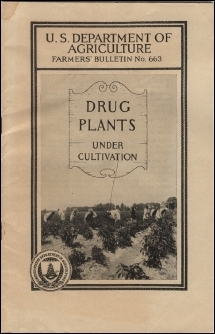Below is a copy of the entry for Cannabis as published in the April 1927 USDA Farmers’ Bulletin No. 663, “Drug Plants Under Cultivation” that Vote Hemp has in its paper archives. The Marihuana Tax Act had not been passed yet and the drug was not yet called “marihuana” or “marijuana.” It is referred to as “cannabis” as they still do in the UK. Later printings of Farmers’ Bulletin No. 663 did not have the listing for Cannabis, though earlier ones did.
Please notice how far apart the USDA had farmers growing the Cannabis plants, how they are tended, and that they even recommended pulling the males to make seedless female flowers! Obviously the USDA was not recommending growing fiber varieties of Cannabisas in Farmers’ Bulletin No. 1935, HEMP. Even though THC had not been discovered yet they knew that the active principle was in the drug-type varieties, but not in the fiber-type or oilseed-type varieties.

U.S. Department of Agriculture
Farmers’ Bulletin No. 663
Drug Plants Under Cultivation
Washington, D.C.
Issued June, 1915
Revised April, 1927
U.S. Government Printing Office: 1929
By W. W. Stockberger, Senior Physiologist in Charge, Drug, Poisonous, and Oil Plants, Bureau of Plant Industry
From the section titled, “THE CULTIVATION AND HANDLING OF DRUG PLANTS”, pp. 16-17.
CANNABIS
The drug cannabis (Cannabis sativa) consists of the dried flowering tops of the female plants. The plant grows well over a considerable portion of the United States, but the production of the active principle is believed to be favored by a warm climate. For drug purposes, therefore, this crop appears to be adapted to the Southern rather than to the Northern States.
Cannabis is propagated from seeds, which should be planted in the spring as soon as conditions are suitable, in well-prepared sandy or clayey loam, at a depth of about an inch in rows 5 or 6 feet apart. The seeds may be dropped every 2 or 3 inches in the row or planted in hills about a foot apart in the row, 6 to 10 seeds being dropped into each hill. Two or three pounds of seed per acre should give a good stand. About half the seeds will produce male plants, which must be removed before their flowers mature, otherwise, the female plants will set seed, thereby diminishing their value as a drug. The male plants can be recognized with certainty only by the presence of stamens in their flowers.
Ordinary stable or barnyard manure plowed in deeply is better for use as a fertilizer than commercial preparations and may be safely applied at the rate of 20 tons per acre. Good results may be obtained, however, with commercial fertilizers, such as are used for truck crops and potatoes, when cultivated in between the rows at the rate of 500 or 600 pounds per acre.
When the female plants reach maturity a sticky resin forms on the heavy, compact flower clusters, and harvesting may then be begun. The tops of the plants comprising the flower clusters are cut and carefully dried in the shade to preserve the green color as far as possible. Drying can best be done, especially in damp weather, by the use of artificial heat, not to exceed 140° F.
For several years cannabis of standard (U.S.P.) quality has been grown on a commercial scale in this country, chiefly in South Carolina and Virginia. After the flowering tops are harvested they are thoroughly dried under cover, then worked over by hand, and all the stems and large foliage leaves removed. This process gives a drug of high quality but greatly reduces the net or marketable yield per acre, which usually ranges from 350 to 400 pounds. Some growers do not remove the stems and leaves, thus increasing the acreage yield but reducing the market value of their product. The quality of cannabis can be determined only by special laboratory tests, which most dealers are not equipped to make; and consequently, they are usually unwilling to pay growers as high prices as they would if the low-grade cannabis were kept off the market.
The market price in January, 1927, for domestic cannabis (U.S.P.) was 23 to 33 cents a pound.